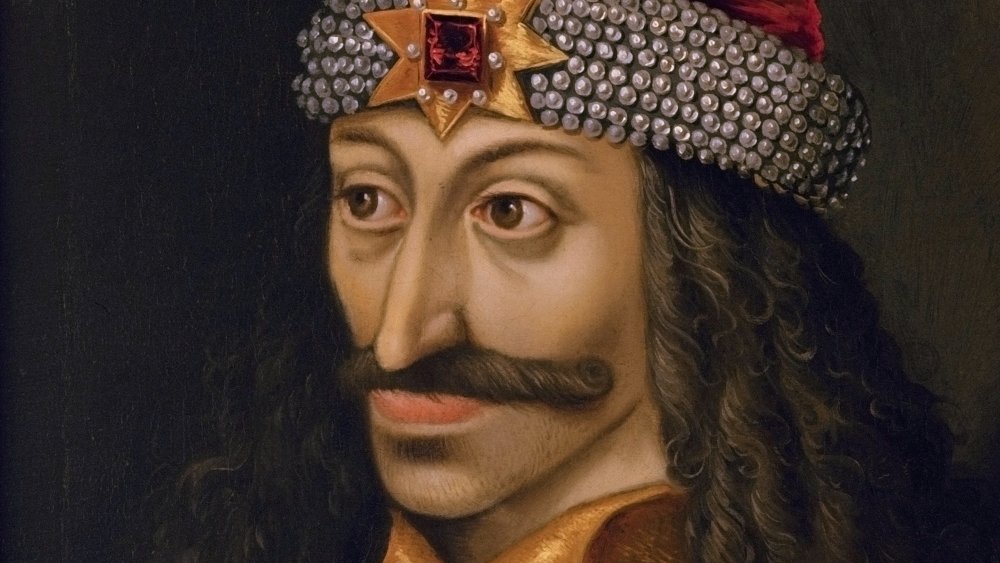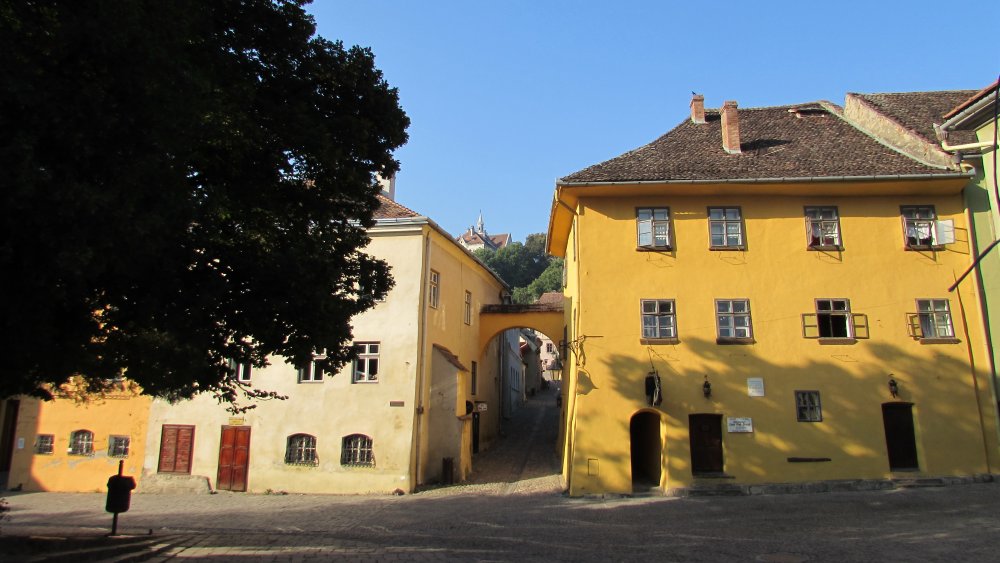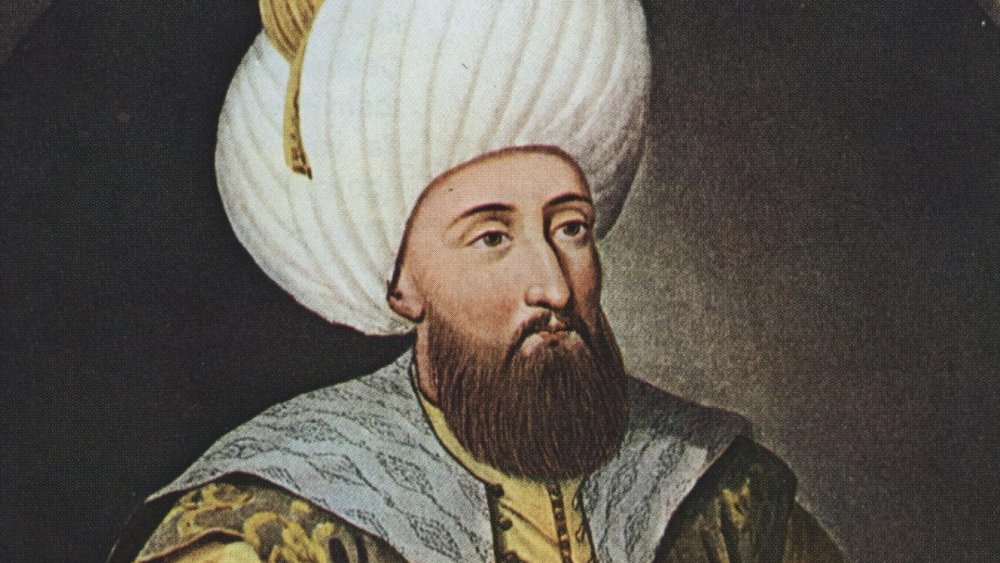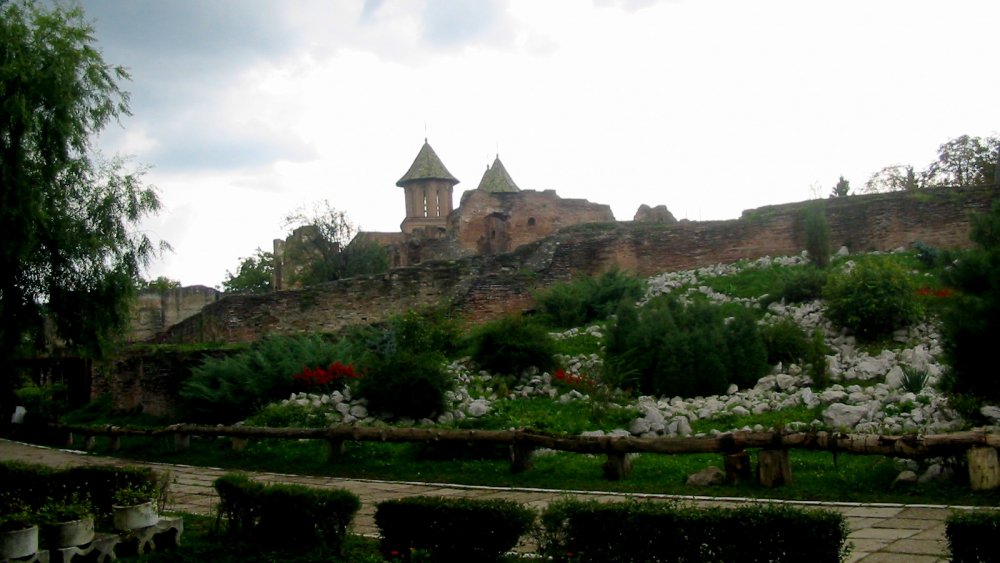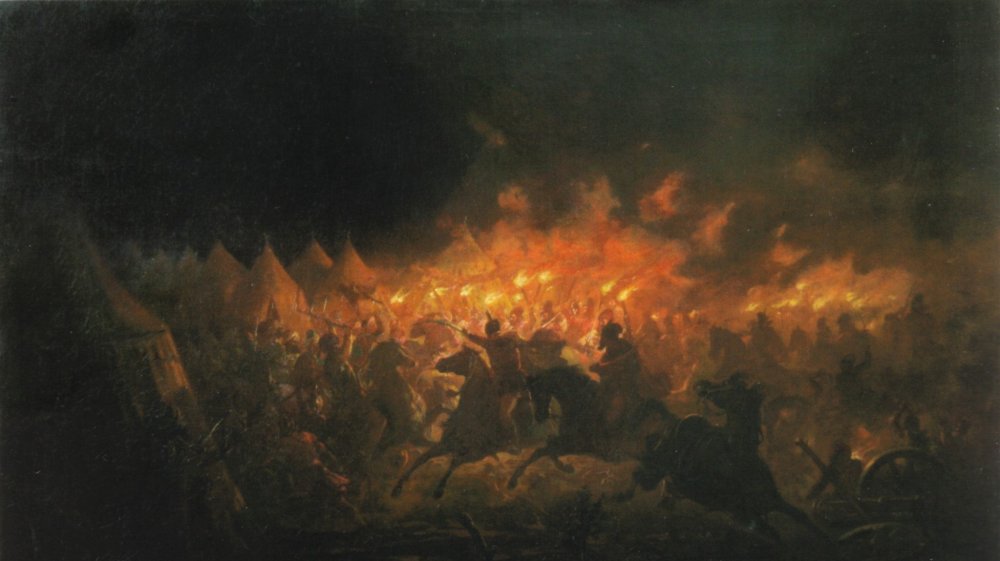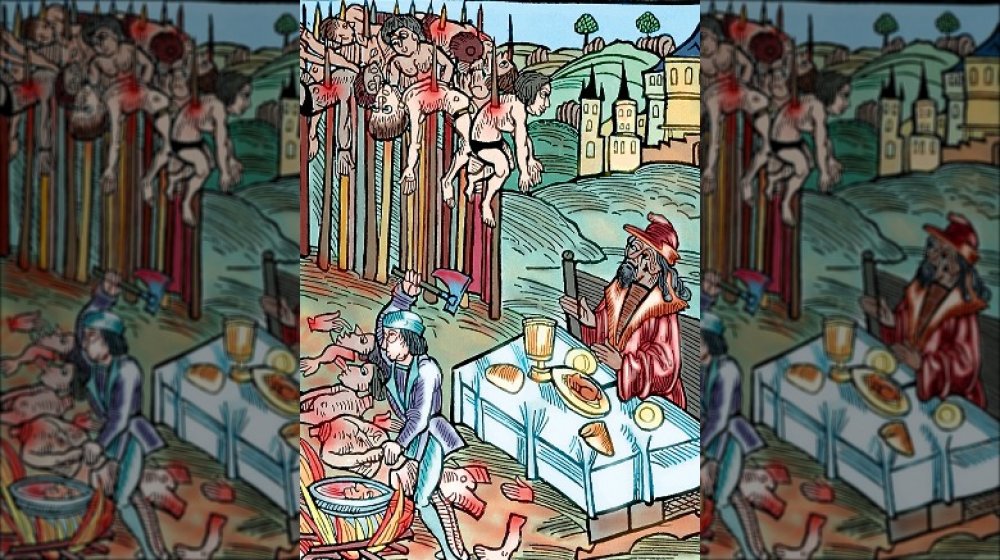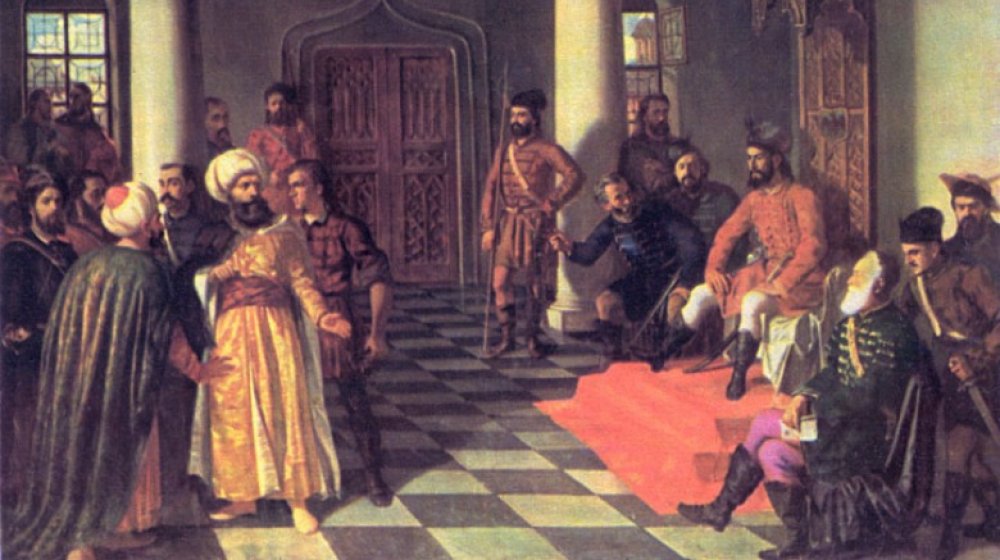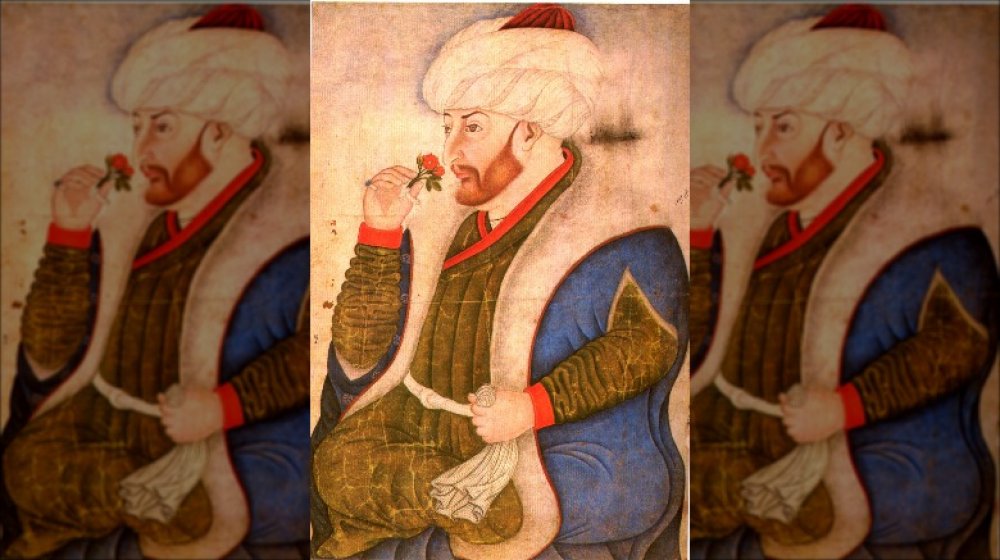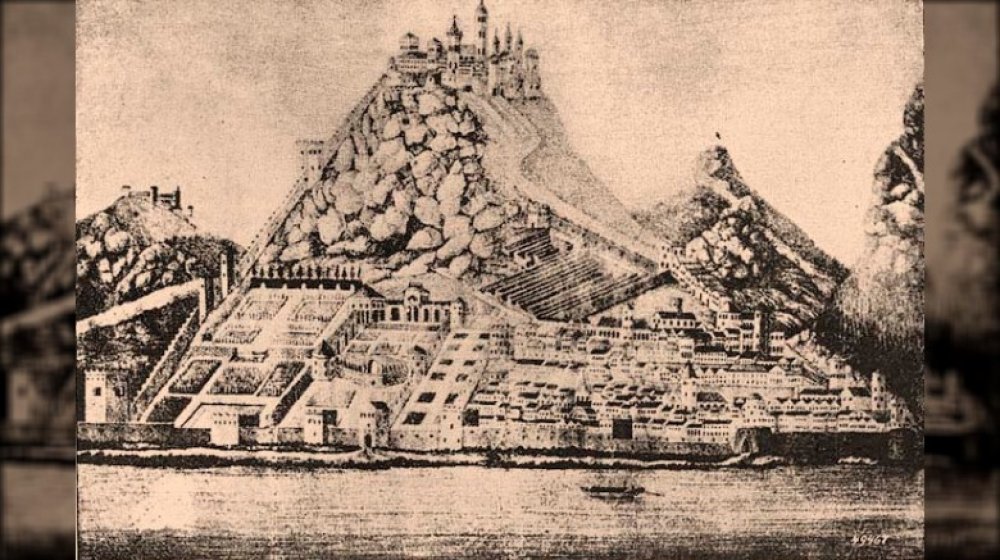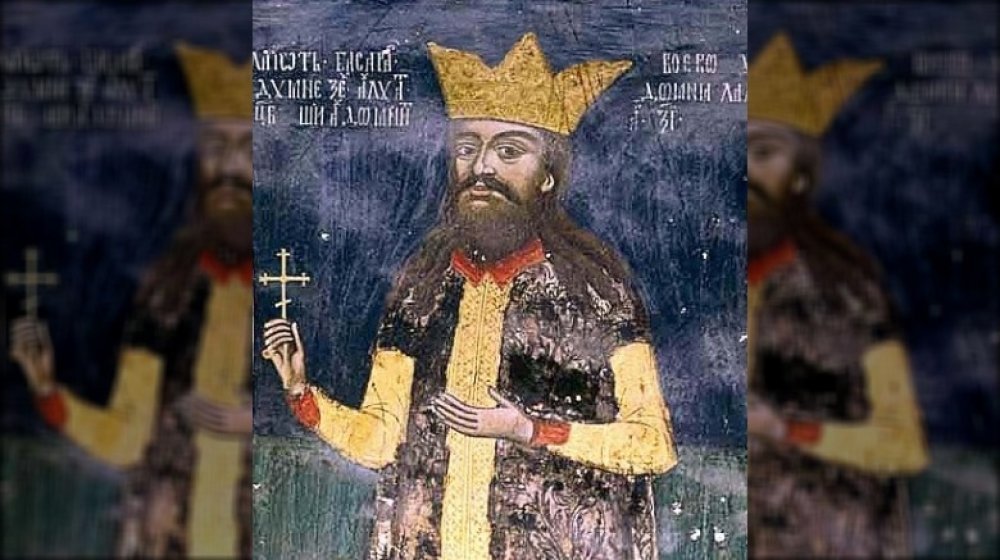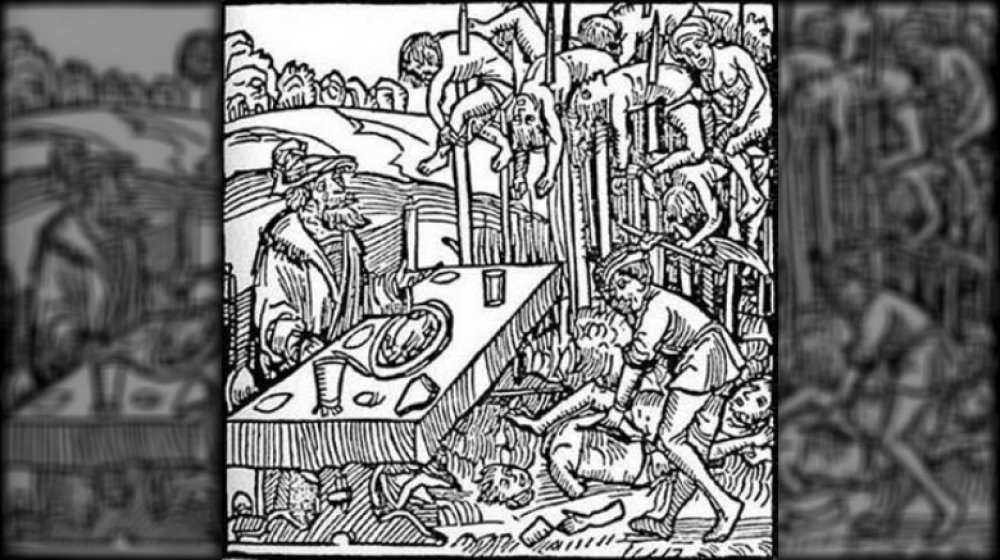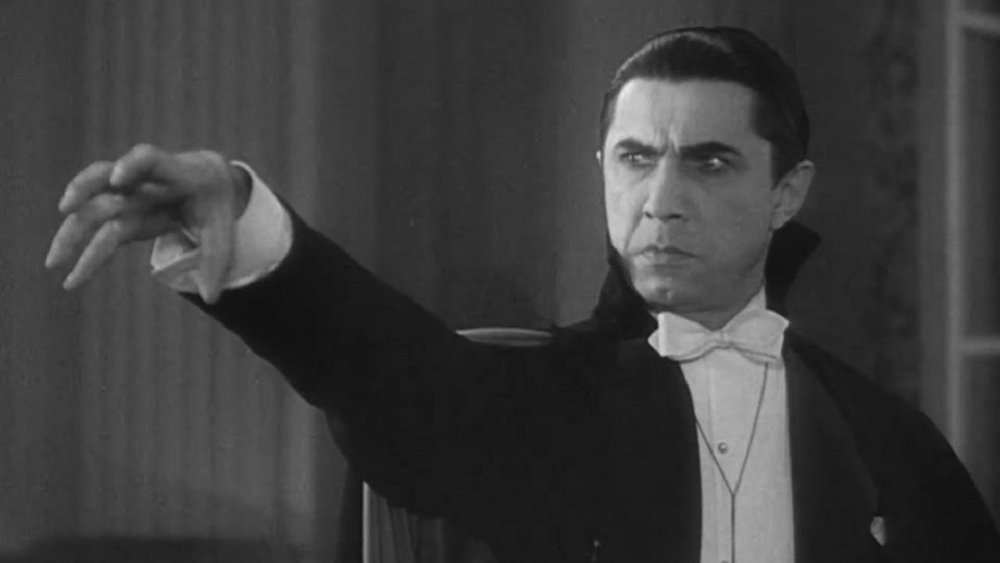The Messed Up Truth Of Vlad The Impaler
Thanks to literally hundreds of books, stories, and movies based on him, perhaps the most famous monster of all time is the king of the vampires, Count Dracula, bat-winged lord of Transylvania and terror of Borgo Pass. But before it became the name of a fictional vampire, Dracula was a name given to a very real historical person. This was Vlad III, a medieval ruler not of Transylvania, but of neighboring Wallachia, a region in modern-day Romania.
During Vlad's life he gained such a reputation for bloody cruelty — some real, some exaggerated — he has come to be known as Vlad the Impaler, after his preferred method of executing those who crossed or offended him. But if all you know about Vlad III is he's a vampire and he liked to poke people with sticks, there's a whole lot more messed up stuff to learn about the real-life Dracula.
Vlad the Impaler was the son of the dragon
Although Vlad the Impaler is perhaps best known for his association with Count Dracula of Transylvania, the real Vlad wasn't a count, nor was he necessarily from Transylvania. As Live Science explains, some reports say Vlad was born in 1431 in his father's residence in Transylvania (a region in what is now Romania), but it is equally likely Vlad was born in Wallachia, the region south of Transylvania where Vlad the Impaler and his father were both princes (or, more accurately, voivodes, a term which really just means a semi-independent local ruler in this area).
Vlad III was, however, really a Dracula. His father was, naturally, Vlad II, known by the honorific title Dracul, meaning "the dragon," because he had been inducted by the king of Hungary into the Order of the Dragon, basically because he was so good at killing Turks. As a result, Vlad III was known as Drăculea, or "son of the dragon," the source of the modern name Dracula (in modern Romanian, the name means "son of the devil," contributing to Vlad's sinister reputation). Vlad III was Vlad II's second son, but he became a legitimate claimant to the throne of Wallachia, as NBC News recounts, after his father was betrayed by local warlords who killed him in a swamp and tortured, blinded, and buried his older brother alive.
Vlad the Impaler spent his childhood as a hostage
Even before his father was murdered by traitors, Vlad III got a taste for treachery at a young age. As Live Science explains, the main conflict of Vlad's life, and indeed, much of Europe at the time, was between Christian Europe and the Muslim Ottoman Empire, whose imperialist designs were rather too close to Eastern Europe for the latter's liking. Both Vlad II and Vlad III spent the majority of their lives repelling incursions into Europe by the Ottomans.
In 1442, however, when Vlad III was only about 11-years-old, his father took him and his younger brother Radu on a diplomatic expedition to the Ottoman Empire to meet with the sultan. The trip, it turned out, was actually a trap, and all three Wallachians were taken prisoner by Murad II. Vlad II was released under the condition he left his two sons as hostages to ensure Wallachia didn't interfere in the war between Hungary and the Ottomans. Vlad and Radu were treated relatively well; they were educated in philosophy, science, and the arts of horsemanship and war (maybe a poor idea for the Ottomans in hindsight). The young Radu was eventually Stockholm syndromed into sympathy for the Turkish cause, but never once in the custody of the Ottomans did Vlad ever turn his mind from his thoughts of revenge.
Vlad the Impaler stole the throne from his cousin as a teen
Vlad III sat on the throne of Wallachia as voivode three times in his life, but his first tenure as ruler was pretty brief. On one hand, he was still a teen when he got it. On the other other hand, he got it in the sneakiest way possible: he basically ran and sat in the big chair while there was no one else around to sit in it.
According to Live Science, Vlad III was still imprisoned by the Ottomans when his father was betrayed by the boyars (the local warlords and noblemen) of Wallachia in 1447. The next year, Vlad was eager to take up his father's seat, which was arguably his by right. However, rule of Wallachia had been overtaken by Vlad's second cousin Vladislav II (yes, those names are confusingly similar), who had aided in the murder of Vlad II and been installed on the throne of Wallachia by John Hunyadi, the governor of Hungary.
While Hunyadi took Vladislav along with him to fight Ottomans in the Balkans, Vlad snuck into Wallachia and grabbed rule for himself at the tender age of 17, with his claim backed by the military support of Ottoman governors along the Danube. Unfortunately for Vlad, Vladislav returned to Wallachia before long, and with Hunyadi against him as well, Vlad's first tenure as voivode lasted a mere two months.
Vlad the Impaler beheaded his traitor cousin
Not much is known about what Vlad got up to between being driven out of Wallachia by Vladislav and his return in 1456, but according to Live Science, we do know during this time he switched allegiances for personal gain. Until this time, Vlad, who had been basically raised in the Ottoman Empire, was supported in his endeavors against Vladislav by Ottoman leaders in northern Bulgaria. But sometime before his return to Wallachia, Vlad turned on his Ottoman allies in order to gain support from King Ladislaus V of Hungary. This was not necessarily for ideological reasons–though Vlad definitely held a grudge against the Ottomans that would soon manifest horrifically–but rather because Ladislaus hated Vladislav nearly as much as Vlad did.
Though the details are somewhat fuzzy at this point, it is known Vlad's anti-Ottoman stance began to pay off as the Turks conquered Constantinople in 1453, and his political and military prowess (ironically obtained from the Ottomans) gained him favor with Hungary as Vladislav fell out of favor at the same time. Vlad invaded Wallachia with Ladislaus's support and, according to a legend retold by NBC News, had the satisfaction of beheading Vladislav in single combat, the first step toward revenge for his father's assassination. By 1456, Vlad had been personally assigned by John Hunyadi to protect the Transylvanian border from the Ottomans.
Vlad becomes the Impaler
In 1456, Vlad III began his second, and longest, tenure as voivode of Wallachia. But as NBC News explains, Wallachia at this time was divided by political bickering and devastated by years of war. This internal strife, notably, was caused by the constant feuding of Wallachia's boyars, who–you may recall–were the ones to betray Vlad II and murder him in a swamp, and whose deaths had probably been part of Vlad III's vision board since he was roughly sophomore-age.
In order to consolidate his power, Vlad began a bloody purge of Wallachia's boyars that he carried out in probably the most extra way possible. He invited hundreds of them to a banquet and when, as expected, they began to challenge his authority, Vlad had his forces stab them and then impale their bodies on wooden stakes, which went in their butts and out their mouths. For some, he would use rounded poles rather than sharp ones in order to prolong his victims' suffering.
It was for this particular habit Vlad would, after his death, gain his well-known nickname: Vlad Țepeș, the Impaler. Though he was known as Dracula in his lifetime, he wasn't known as the Impaler except posthumously. Nevertheless, his reputation for staking up his foes–and even dining among the impaled corpses of his victims–was well known throughout Europe by his contemporaries.
Vlad the Impaler's reign of terror
Though Vlad succeeded in consolidating power and bringing stability to Wallachia, he did so through vicious cruelty. Thanks to his rule coinciding with the rise of the printing press, tales of his violent nature spread throughout Europe during his lifetime. Though, as Live Science says, it can be hard to separate fact from legend, it's thought some of the stories have a basis in reality.
One of the most likely bloody events with which Vlad is credited is the impaling of dozens of Saxon merchants in the city of Kronstadt who had once been allied with Wallachia's boyars. Early German stories of Vlad go so far as to say he carried off men, women, and children from a Saxon village to Wallachia to be impaled.
Another story from this time claims Vlad was approached by a diplomatic envoy of Ottomans who refused to remove their turbans in front of the voivode, stating it was against their religion. Vlad congratulated them on their religious devotion and said he would do what he could to make sure they were always so pious. He subsequently had the men's turbans nailed to their heads so they would never have to remove them again. As NBC News reports, during this time, Vlad himself claimed to have killed "peasants, men and women, old and young," and tens of thousands of Turks, whom his men burned or beheaded.
Vlad the Impaler's forest of corpses
By 1461, Vlad had made something of a career of antagonizing the Ottomans. In the first five years of his second reign as voivode of Wallachia, he had not only burned, beheaded, boiled, flayed, and–of course–impaled tens of thousands of Ottomans, he added insult to those literal injuries by ceasing to pay the annual tribute the Ottoman sultan demanded of those on the borders of his empire. In fact, as Mental Floss recounts, when the sultan sent envoys to Wallachia to collect the delinquent payment, Vlad killed them and, perhaps needless to say, put spikes up their butts. To really drive the point home, Vlad crossed into Ottoman territory and destroyed everything in eyeshot.
The sultan, obviously a little salty about this, gathered a force of about 90,000 dudes (about the size of the one he had used to topple the Byzantine capital, Constantinople) to invade Wallachia. When Vlad's guerrilla tactics such as poisoning wells and ambushing Ottoman troops failed to stop the sultan from camping just outside the Wallachia capital, Vlad decided to raid the sultan's camp and assassinate him personally. Unfortunately, he attacked the wrong tent and only killed the sultan's top advisers. But when life gives you corpses, make corpseade: when the sultan advanced on the city, he found the gates open, the city deserted, and outside it a forest of some 20,000 impaled Ottoman prisoners of war. The sultan was so wigged out, he turned tail and went back to Turkey.
Vlad the Impaler betrayed by his best friend
Despite (or perhaps because of) his harsh tactics, Vlad had impressed many throughout Christian Europe with his victories over the Ottomans. Even the pope was in his corner. That said, he wasn't without challenges. As Mental Floss explains, as the sultan was fleeing Vlad's dead body wonderland, he left behind Vlad's younger brother Radu, loyal to the Ottomans, to challenge Vlad for the throne. Radu managed to gather a lot of support in Wallachia from the boyars, whom you may remember Vlad had made a habit of murdering and skewering.
If a rebellion of local nobles and betrayal by his own brother weren't bad enough, Vlad was also betrayed by a man who was supposed to be his friend, Matthias Corvinus, the so-called Raven King of Hungary. By 1462, Vlad had nearly wiped out all of Wallachia's resources due to constant warfare with the Ottomans despite having been aided monetarily by the pope, and so he sought aid from Corvinus. As Europe Between East and West explains, though, instead of helping Vlad, Corvinus forged letters making Vlad look like a traitor to Europe and Christendom that he then sent to said pope. Vlad was subsequently put on house arrest in a palace in Hungary for the next 12 years, where he allegedly passed the time by capturing birds and mice and beheading and impaling them. Classic Vlad.
Vlad the Impaler's last stand
While Vlad was exiled in Hungary, his younger brother Radu, who had sided with the Ottomans, sat on the throne of Wallachia. But when Radu died in 1475, as Live Science explains, the boyars started feeling nostalgic for the good old impaley days and began campaigning for Vlad's return to power. And so in 1476, thanks to the help of the voivode of Moldavia, Vlad was able to steal back the throne one final time, driving the Ottoman-approved Basarab Laiotă out of Wallachia and into the protective arms of the sultan. Unfortunately, Vlad's third reign was just as short as his first: two months after once again ascending to the throne, Vlad and his cohort of troops were ambushed by Ottomans while on their way to battle, and Vlad was killed by Basarab Laiotă, puppet of the same sultan Vlad had earlier repelled with his corpse forest.
According to reports collected by NBC News, Vlad's body was cut to pieces and his head sent to the sultan, who placed it on the gates of Constantinople as a trophy. No one knows for sure where Vlad III was buried, and there is no small controversy on the topic. Some claim he was buried in a monastery near Bucharest, while others argue his remains were placed in a different monastery closer to where he was killed.
The legendary cruelty of Vlad the Impaler
Vlad III Dracula is the kind of dude who is so legendary, it is often very difficult to separate what is true from what is, well, legendary. As mentioned before, tales of his harsh rule and deadly sense of what was just spread easily throughout Europe thanks to the advent of the printing press. A Russian account of the deeds of Vlad written contemporary to his life known as The Tale of Prince Dracula contains many of the most famous legends of Vlad's cruelty. Interestingly, the author of this work seems to express a morbid appreciation for the Impaler's stern justice.
Anecdotes featured in this work include how when his troops returned from battle, he would give honors to those wounded on the front of their bodies and would impale those with injuries on their backs (because they would have been running away, you see). It also reports how their was basically no crime in Wallachia during Vlad's rule for fear of how he would punish thieves; to drive the point home, Dracula kept a golden cup by a public spring that no one dared steal. It also tells of how when a servant complained about the smell of the impaled corpses Vlad dined among, Vlad had him impaled high above the other bodies so he wouldn't have to smell the stench. Also included is the very famous story where Vlad burned a hall full of poor people so no one would have to suffer from poverty in Wallachia.
Vlad the Impaler is Romania's murderous national hero
While in most of the world, Vlad the Impaler is best known due to his association with the King of the Vampires, in his home country of Romania, that's not his reputation at all. In fact, as the Los Angeles Times reported back in 1994, Romanians were pretty shocked to learn the global reputation of Dracula upon the release of Francis Ford Coppola's adaptation of Dracula in 1992. Vlad was never associated with vampires there, partly because the Communist regime forbade talk of folklore and superstition, but mostly because Vlad III is considered basically the greatest hero in Romanian history. Despite his cruelty and his murder of reportedly up to 80,000 people, Vlad is considered a staunch defender of the Christian world, and he is admired for his strict sense of justice that legendarily kept people from, for example, stealing that golden cup from the well.
In fact, the only national epic poem written in Romania is about Vlad the Impaler, and he's the hero. Tiganiada was written in the 18th century by the Transylvanian poet Ion Budai-Deleanu and tells the story of Vlad leading an army of angels and Roma against boyars, Turks, demons, and–perhaps ironically–vampires. Additionally, the 1979 movie Vlad Tepes depicts even Vlad's cruelest acts as heroic in a piece of nationalist propaganda for the Communist regime.
Dracula isn't actually based on Vlad the Impaler
If you know only one fact about Vlad the Impaler–well, first of all, go back and actually read this article because it's jam-packed with facts about Vlad the Impaler. But if you only know one fact about Vlad the Impaler, it's that he served as the inspiration and model for Bram Stoker's 1897 novel Dracula, which changed vampires from a niche Eastern European superstition into, like, the monster.
Well, no. He didn't really. As io9 points out, there is basically zero evidence Stoker had any idea who Vlad III was. The novel Dracula contains no mention of the name Vlad, no mention of impaling, and no mention of Vlad's legendary cruelty. Stoker's notes indicate he found a book about the history of Wallachia that mentioned the region had had several rulers with the name Dracula, and that this name indicated courage, cruelty, and cunning. In fact, Stoker's notes literally have him writing "DRACULA in Wallachian language means DEVIL," in caps like that. It's pretty clear he had found a name which gave him the diabolical associations he wanted and he had never actually heard anything about nailing turbans to heads or what have you. Still, the association is indelible at this point and has brought no shortage of tourism dollars to the Carpathians from those hoping to catch sight of a vampire or maybe just the ghost of a guy who really hated Turkish people.
